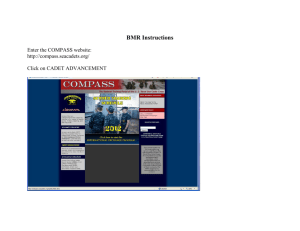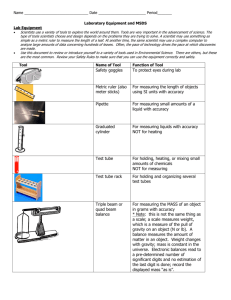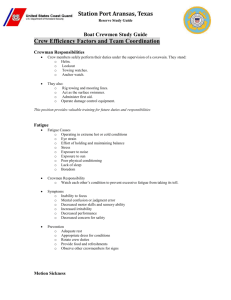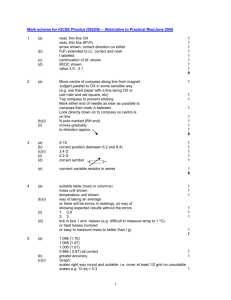Boat_Crew_Notes - Boatswainsmate.net
advertisement
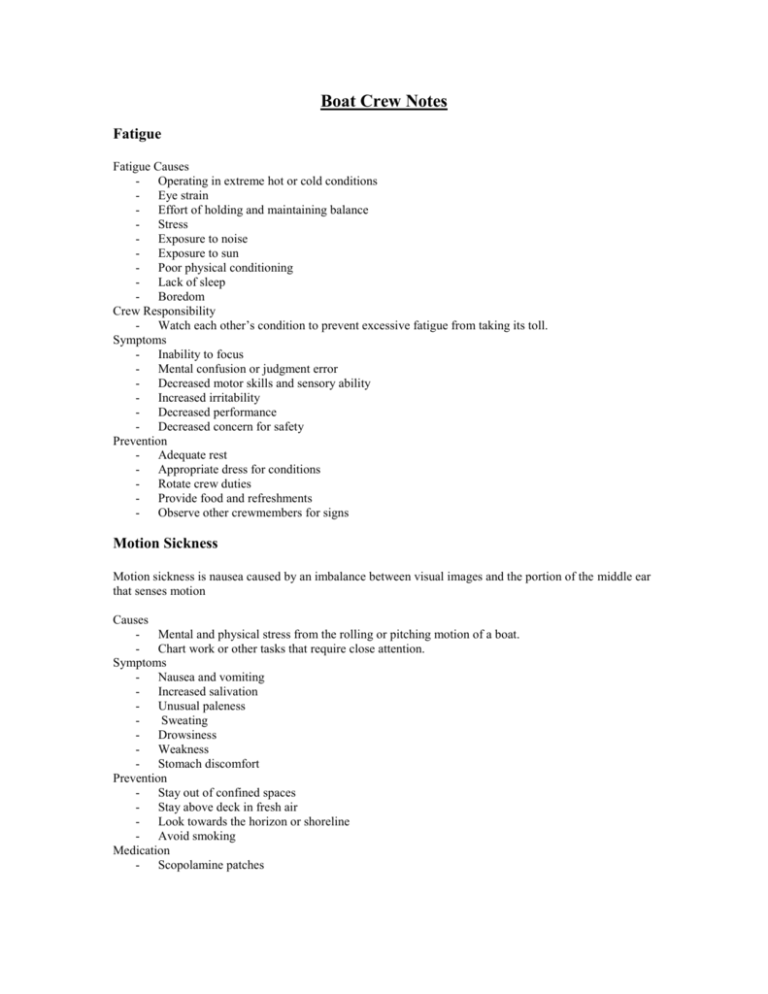
Boat Crew Notes Fatigue Fatigue Causes - Operating in extreme hot or cold conditions - Eye strain - Effort of holding and maintaining balance - Stress - Exposure to noise - Exposure to sun - Poor physical conditioning - Lack of sleep - Boredom Crew Responsibility - Watch each other’s condition to prevent excessive fatigue from taking its toll. Symptoms - Inability to focus - Mental confusion or judgment error - Decreased motor skills and sensory ability - Increased irritability - Decreased performance - Decreased concern for safety Prevention - Adequate rest - Appropriate dress for conditions - Rotate crew duties - Provide food and refreshments - Observe other crewmembers for signs Motion Sickness Motion sickness is nausea caused by an imbalance between visual images and the portion of the middle ear that senses motion Causes - Mental and physical stress from the rolling or pitching motion of a boat. - Chart work or other tasks that require close attention. Symptoms - Nausea and vomiting - Increased salivation - Unusual paleness Sweating - Drowsiness - Weakness - Stomach discomfort Prevention - Stay out of confined spaces - Stay above deck in fresh air - Look towards the horizon or shoreline - Avoid smoking Medication - Scopolamine patches Team Coordination Seven Team Coordination Skills - Leadership - Mission Analysis - Adaptability & Flexibility - Situation Awareness - Decision-Making - Communication - Assertiveness Bleeding Control Control of severe hemorrhage is always urgent. With only 10 pints of blood in the human body, arterial bleeding can cause death in a short time. Types of Bleeding - Arterial o Blood coming from an artery, bright red, gushes in jets with pulse - Venous o Blood coming from a vein, dark red, steady flow - Capillary o Blood coming from smaller vein, bright red, oozes from wound Control of Bleeding - Bandage - Direct Pressure - Pressure Points o Facial o Temporal o Subclavian o Carotid o Axiillary o Brachial Child pulse o Radial o Femoral o Popliteal o Doralis Pedis - Tourniquet Burns Causes of burns - Thermal - Chemical - Sunburn - Electric Shock - Radiation Burn Classification / Burn First Aid - First-Degree o Outer layer of skin, redness, warmth, tenderness and mild pain. Immerse in cool water Flush chemical for 20 min Cover with clean sterile dressing - Second- Degree o Inner Layers of skin, not prevent rapid regeneration, blisters, severe pain, redness and warmth. Same a 1st Don’t break blisters - Third-Degree o Penetrate full thickness of skin, possible white and lifeless to black. Same as 1st and 2nd Cover burn reduce air exposure Don’t remove clothing unless smoldering Treat for shock Assess vitals every 5 min. No ice No ointment CPR CPR Procedures - Area safe - PPE, Gloves etc. - Check responsiveness “Are you OK?” - Notify EMS - Put on their back - Tilt head back - Look, Listen & Feel for 5-10 sec. - 2 breaths 2 sec. each - Look, Listen & Feel - 2 breaths to 30 compressions Hypothermia & Cold Water Survival Hypothermia Symptoms - Pale - Skin cold - Pupils are dilated - Poor coordination - Slurred speech - Incoherent thinking - Unconsciousness - Muscle rigidity - Weak pulse - Labored breathing - Irregular hear beat (HELP) Heat Escape Lessoning Position Heat Exhaustion Symptoms - When suffering from heat exhaustion, a person collapses and sweats profusely. The victim has pale skin, a pounding heart, nausea, headache, and acts restless Heat Stroke Symptoms - Red skin, hot and dry to the touch (cessation of sweating). - Characteristic body temperature above 105° F (40.5° C). - Headache. - Weak and rapid pulse. - Confusion, violence, lack of coordination, delirium, and/or unconsciousness. - Brain damage (if immediate medical treatment is not given). Survival Vest and Contents Survival Vest - Type V PFD - 6 pockets Contents - Signaling Mirror o Great Distances - Signal Whistle o Heard up to 1,100 yards Smoke and Illumination Signal, MK-124 o 20 sec. burn time, day end orange smoke, night end red flair, 45° Illumination Signal Kit, MK-79 o 250-650 feet, 4.5 sec burn time, 12,000 candle power, 7 MK-80s & 1 MK-31 Distress Signal Light o Intermittent flashing white, 100,000 candle power, 9hr cont. 18hr inter., vis. 5 miles Survival Knife Personal Locator Beacon o 406 MHz & 121.5 MHz, within 3NM in 90min., Capsizing & Emergency Egress Egress Procedures - Brace for impact - Remain strapped in until motion has subsided - Plan egress with crew o Best swimmer first then the weakest swimmer - Swim clear and away Muster account for missing Remain upwind/up current Attempt to climb on hull Check injuries provide first aid Inventory signaling equipment, PLB Check for gas before lighting off pyro Stay with the boat Boat Nomenclature & Terminology Boat Outfit List & Stowage Plan - - - Anchor Compartment o Fortress 7lb Anchor o 250ft Anchor line o 3/8” Galvanized anchor shackle (4 ea) o 3/8” Galvanized swivel o ¼”x4’ PVC coated anchor chain o 5 ½”x20” Fender (2 ea) o 25’ Mooring Lines 2” or 2 ¼” DBN FWD Compartment o Fire Extinguisher FWD Compartment (B Class) o Spare kill switch lanyard o 3/16” T-Allen wrench o 90° Phillips screwdriver FWD STBD Seat o Nav. Kit Briefcase w/ CG logo Pencils China Markers Gum Eraser Note Pad Stop Watch Compass / Dividers Parallel Rule Weems Plotter Search Pattern Slide Rule Nautical Slide Rule Coast Pilot Nav. Rules Light List - - - - - - Chart One Anemometer Red Flash Light AOR Charts (14770, 14771, 14772, 14773, 14774, 1433, 1434, 1435) Pencil Lead Sharpening Pad STBD Seat o First aid kit o Hand bilge pump Electronics o Nav. Lights o Blue Lights o Flood Lights o Interior / Exterior Deck Lights o Instrument Lights o Fathometer o Radar o GPS o VHF Radios o Loudhailer / Horn Port FWD Seat o 12 Volt gel cell Batteries (3 ea) Port Center Seat o Tool Kit 10w30 Lube Oil (2 qts) Phillips & Slotted Screwdriver Metric Wrench Set (10mm-20mm) Pliers Rags Hub Kit Spare Kill Switch (2 ea) 3/16” T-Allen Wrench 90° Phillips Screw Driver Spark Plug Wrench w/ 4” extension Prop Nut Wrench Port Aft Seat o Gear Bag 1 ½” DBN Skiff Hook Line 9’ SS Shackles (3/8” & ½”) Mousing Wire Ties (4 ea) Flashlight Dewatering Pump Tie Down Strap o 5 ½”x20” Fender (2 ea) o 25’ Mooting Lines 2” or 2 ¼” DBN o 35’ Alongside Lines 2” or 2 ¼” DBN Main Deck o National Ensign o CG Ensign o 300’ Towline DBN 2 ¼” w/ cover (A Class) o 150’ Towline DBN 2 ¼” w/ cover (B Class) o 24” Throwable Life Ring o Life Ring Strobe Light o 406 MHz CAT II EPIRB o Throw Line Bag o 8’ Boat Hook w/ skiff hook STBD Deck Locker o Fire Extinguisher (Type B-1) - Various o o o o o o o o o o o o o Type V PFD (4 ea) Binoculars Lighting Rod Towing Mast Light 8’ 8’ Boat Hook w/ skiff hook Trim / Tilt Steering Fluid Level Foam Collar Props Boat Hours Oil Level Fuel Level Windshield Wiper Fluid Level Boat Characteristics & Specifications Brief Info - Design o Deep-V, rigid mono-hull - Hull and Deck o ¼inch 5086 Marin grade aluminum - Cabin o 5052 Marine grade aluminum - Collar o Polyethylene - Manufacturer o SAFE Boat International - Windows o 12 A Class o 14 B Class - Cabin Dewatering Pump o Rated 1100 gallons per hour @ 2 ½inch of water A Class located centerline under cabin step B Class located starboard aft passenger seat - Manual Bilge Pump o 10 strokes per gallon and 6 gallons per minute - Heading Sensor o Located centerline aft bulkhead under the step - Number of Frames o 20 - Water Tight Bulkhead o Frame 16 - Diesel Fuel Heater Tank o A Class 6gal port weather deck o B Class 2.5gal starboard aft deck locker - Engine Weight o 633 pound - Horn o 106 dB - Throw Line Bag o 70-100ft work load 500lb 3/8” - Life Ring Strobe Light o 36hr continuous - EPIRB - - - o 0.05NM, with in 5 min Steering Wheel o Mono ® 16” 3 spoke Searchlight o A Class 200,000 candle power, tilt 9° up and 17° down o B Class 180,000 candle power Fuel Consumption o A Class 46kts 40gph o B Class 46kts 44gph Magnetic Compass Location Alpha Missions - Defense Operations - Port Safety & Security - Recreational Boating Safety - Marine Environmental Protection - Enforcement of Laws & Treaties - Maritime Safety & Security - Search & Rescue Physical Characteristics - Design Length of Hull o A Class 25’ o B Class 25’ 2 ½” - Length Overall o A Class 29’ 4” o B Class 29’ 6 ½” - Length at Waterline o A Class 22’ 6” o B Class 22’ 8 ½” - Beam Overall o 8’ 6” - Operational Draft o 39” - Draft Engines Tilted Up o 23 ¼” - Height of Nav. Mast on Trailer o 12’ 8” - Height of Radar Dome Trailer o 11’ ½” - Height of Search Light Trailer o 9’ 7” Bravo - Highest Fixed Point Trailer o 9’ ½” - Crew Capacity o 4 Seating Total = 10 - Passenger Capacity o 6 - Fuel Tank Capacity o A Class 125gal @ 95% = 119gal o B Class 105gal @ 95% = 100 gal - Propulsion o 2 Honda 225-HP 4 Stroke - Propeller o 14x19 Mercury Offshore or Vensura - Boat Weight o 7400 - Max Weight o 9200 - Weight o 9450 Operational Characteristics - Max Speed o 46kts @ 6000RPM - Cruise Speed o 35kts @ 4500RPM - Max Range o A Class 175NM o B Class 150NM - Wind o 25kts - Sea o 6ft - Towing o 10 displacement tons - Operation Offshore o 10NM - Air Temp o 0 – 105°F - Water Temp o 28 – 95°F Stability - - Center of Gravity o Weight of the boat acts vertically downward, lower center of gravity more stable. When weight is add the center of gravity moves with the direction of the weight being add. Buoyancy o Upward force of water displaced by the hull Equilibrium o Buoyancy over gravity - - - Rolling o Downward force of gravity is offset by upward force of buoyancy Heeling o The center of gravity is no longer in line with the center of buoyancy Listing o Center of gravity is not on the centerline, boat will heel until equilibrium is reached Types of Stability o Longitudinal Fore & Aft, preventing it from pitching end-over-end o Transverse Athwartships, Keeps the boat from rolling over Static & Dynamic Forces o Static Internal forces o Dynamic External forces Anchoring 1.) Shank – Aids in setting & weighing the anchor. Attachment point for the anchor for the anchor line 2.) Flukes – Dig in the bottom & bury the anchor, providing holding power 3.) Crown – Lifts the rear of the flukes, & forces the flukes into the bottom 4.) Stock – Prevents the anchor from rolling or rotating Scope of Line - Ratio range between 5:1 & 7:1 o (Example: for the 5:1 ratio, anchoring in 20ft of the rope should be 100ft) Anchor Description - Fair - Fowled - Shawed Common Navigation Lights Port Light - Red Starboard Light - Green Light Configuration - Sidelight – 112.5* - Masthead Light – 225* - Stern Light – 135* - All around – 360* Navigation Lights - Sailing o Red / Green Trawling o Green / White Fishing o Red / White Restricted in Ability to Maneuver o Red / White / Red Not Under Command o Red / Red Constrained by Draft o Red / Red / Red Pilot o White / Red Anchor o Masthead Lights Aground o Red / Red Sound Signals International - * Alter course to starboard - ** Alter course to port - *** Astern propulsion - -*-* Agree to overtaking - - Bend signal - ***** Danger - --* Intend to overtake on starboard side - --** Intend to overtake on port side Inland - * I intend / agree to port to port passing - ** I intend / agree to starboard to starboard passing - *** Astern propulsion - ***** Danger - - Underway Distress Signals Red Star Shells Fog Horn Continuous Sounding Flames on a Vessel Gun Fired at Intervals of 1 min. Orange Background Black Ball & Square SOS “Mayday” by Radio Parachute Red Flare Dye Marker Code Flags November Charlie Square Flags & Ball Wave Arms Radio-Telegraph Alarm Radio-Telephone Alarm Position Indicating Radio Beacons Smoke Inland Only High Intensity White Light Radio Communication CH (6) / 156.3 MHz SAR Ship – Ship CH (12) / 156.6 MHz Ship – Ship CH (13) / 156.65 MHz Bridge – Bridge CH (16) / 156.8 MHz International Distress CH (21) / 157.05 MHz Intra CG (Secondary) CH (22A) / 157.1 MHz CG – Non CH (23A) / 157.15 MHz (Primary) CH (81) 157.075 MHz CH (83) 157.175 MHz Variation and Deviation Variation - Magnetic variation is the difference between true bearings and magnetic bearings and is caused by the different locations of the Geographic North Pole and the Magnetic North Pole plus any local anomalies such as iron deposits. Variation is the same for all compasses in the same location and is usually stated on good quality maps and charts, along with the date it was measured. Deviation - Magnetic deviation is the difference between magnetic bearings and compass bearings. Deviation varies for every compass in the same location and depends on such factors as the magnetic field of the boat, wristwatches, etc. The value will also vary depending on the orientation of the boat. Magnets and/or iron masses can be used to correct for deviation so that a particular compass will accurately give magnetic bearings. More commonly, however, a correction card will be drawn up listing errors for the compass which can then be compensated for arithmetically. Correcting & Uncorrecting for Compass Error “Correcting” is going from magnetic direction (M) to true (T), or going from the compass direction (C) to magnetic (M). To apply compass error to correct course or direction: • Take the compass course. • Apply deviation to obtain the magnetic course. • Apply variation to obtain true course. The sequence of the procedure is outlined below: • Compass (C). • Deviation (D). • Magnetic (M). • Variation (V). • True (T). MEMORY AID Applying compass error: Can Dead Men Vote Twice At Election (Compass) (Deviation) (Magnetic) (Variation) (True) (Add) (Easterly error) Add easterly errors - subtract westerly errors For the compass course is 127°, variation from the compass rose is 4° W, and the deviation from the boat’s deviation table is 5° E. Then, the true course (T) is obtained as follows: Step Procedure 1.) Write down the correction formula: • C = 127° • D = 5° E • M = 132° • V = 4° W • T = 128° 2.) Compute the information opposite the appropriate letter in the previous step. 3.) Add the easterly error of 5° E deviation to the compass course (127°) and obtain the magnetic course of 132°. 4.) Subtract the westerly error of 4° W variation from the magnetic course (132°). 5.) The true course is 128°. Converting from true (T) direction to magnetic (M), or going from magnetic (M) to compass (C) is “uncorrecting”. For converting from true course to compass course: • Obtain the true course. • Apply variation to obtain the magnetic course. • Apply deviation to obtain the compass course. MEMORY AID Converting true course to compass course: True Virtue Makes Dull Company After Wedding (True) (Variation) (Magnetic) (Deviation) (Compass) (Add) (Westerly error) Subtract easterly errors - add westerly errors Dead reckoning (DR) Dead reckoning is the determination of approximate position by advancing a previous position for course and distance only, without regard to other factors, such as, wind, sea conditions and current. Dewatering Pump (USCG-P6) Description - 6 ½hp 4 cycle engine - 3inch suction and discharge hoses - Priming at 12ft in less than a minute - 250 gpm - 4 gallon fuel tank Stokes Litter 1.) Gray 2.) Blue 3.) Red 4. )Green 5.) Black
